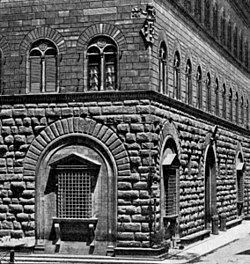

Kneeling windows (Italian : Finestra inginocchiata) is a type of opening used from the fifteenth century, especially in the Tuscany area.


Kneeling windows (Italian : Finestra inginocchiata) is a type of opening used from the fifteenth century, especially in the Tuscany area.
It is a monumental type used especially on the ground floor: the sill rests on supports protruding that resemble those of a kneeler's bench. Typical of the Mannerist and Tuscan Baroque periods, it is usually enclosed by a grille, framed and crowned by tympanum, sometimes with decorations, often zoomorphic: for example, the two supports are often carved as lion's paws and sometimes the space between them is decorated with a bas-relief.
The first kneeling window is traditionally the one in Palazzo Medici Riccardi in Florence, attributed to Michelangelo. [1] It was made to occupy the large arch of a portal that once led to a family loggia.
Among the architects who indulged in the creation and decoration of kneeling windows were Bartolomeo Ammannati and Bernardo Buontalenti.